
https://www.dailygrail.com/2022/05/led-zeppelin-guitarist-jimmy-pages-intense-visits-to-the-great-pyramid-and-sphinx/
Still fun to ponder …
I’ve always loved rock and roll, but I never thought I’d get involved with it in any tangible way. A few years ago I was kicking around ideas for summer workshops and came up with the idea that something on Led Zeppelin and the occult might be fun, for me. I never thought anyone else would care about it. A few months later I’m at the Starwood festival with almost 100 people under a tiny little canopy, cranking up the Zeppelin and talking about Aleister Crowely. It was amazing. Couple the Zeppelin talks with Morrison Rituals, and all of a sudden I’ve cornered the market on Pagan rock and roll presentations.
This whole Led Zeppelin and the Occult thing is really important to me because the Zep was my gateway into Paganism. Jimmy Page’s fascination with Aleister Crowley led me to want to know more about Crowley, and forced me to get over the stereotype that anyone who is not a Christian is a Satanist. Robert Plant’s interest in Celtic Mythology opened the door into the world of modern Witchcraft, the ancient Druids, and a whole mess of bad Llewellyn books. Led Zeppelin laid the groundwork for my walk with the Goddess and God, and I have a feeling that I’m not alone. The response I get when talking about Zeppelin is confirmation of that, as is you reading this!
I was 17 when I got serious about listening to Led Zeppelin. The year was 1990 and Atlantic Records had just released the four disc “Led Zeppelin Boxset” that fall. As a heavy metal fan I knew that I had to have it, but I didn’t really know why. Of course I was familiar with Led Zeppelin, who hasn’t heard “Rock’n’Roll” “Black Dog” “Whole Lotta Love,” and of course “Stairway to Heaven?,” but the Zeppelin catalog is so much deeper than what classic rock radio would have you believe.
Over the next few months I lost myself in the Zeppelin, by May of that year I had become a fanatic.
For a period of time in college I tried to convince my friends that my nickname should be “Led,” that’s how bad (or sick) my Zeppelin jones was (anyone catch that pun?), oh who am I kidding, is. As I’ve grown older I’ve found new things to appreciate about the band, and because modern rock music basically blows serious chunks, Zeppelin has become popular again, almost hip. So popular in fact that Zeppelin clothes are easier to find now than they were ten years ago.
The pseudo-goth-punk rock mall chain Hot Topic said in 2006 that their best selling t-shirt ever was a Led Zeppelin one. The particular shirt in question was nothing all that special, just the Swan Song Record label logo (that was Zeppelin’s vanity label for the uninitiated) and some lettering that read “North American Tour 1977, ” but to many that logo was a mystery. Now that little falling angel logo has never been much of a mystery to me, it’s just a picture of Apollo adapted from the painting “Evening: Fall of Day” by William Rimmer. Contrary to a few published reports, it’s not Lucifer, its not even Icarus, but that’s what makes Zeppelin so much fun, a hidden promise of the sinister cloaked behind English blues rock.
Led Zeppelin and the Blues
Zeppelin was a blues band, and the influence of the blues is all over their music, but it goes farther than that. The legends of Led Zeppelin are also built around the myths of the blues. One of the oldest blues myths is that of the crossroads, you know the one, where young bluesmen go to make a deal with the devil at the crossroads in order to obtain mastery of their craft (usually the guitar). Jimmy Page was said to have led Led Zeppelin (perhaps minus bass player John Paul Jones) in that very rite back in 1968. Music has always been associated with Satan, and it’s not surprising that the blues became associated with Jack Scratch.
However in the case of the blues, some of this story might very well be true. One old bluesman summed up the crossroads experience like this:
If you want to learn how to make songs yourself, you take your guitar and you go to where the road crosses that way, where a crossroads is. Get there, be sure to get there just a little ‘fore 12 that night so you know you’ll be there. You have your guitar and be playing a piece there by yourself…A big black man will walk up there and take your guitar and he’ll tune it. And then he’ll play a piece and hand it back to you. That’s the way I learned to play anything I want.”
Myths such as the one above were popular in the South in African-American communities; mostly because magic was still a part of people’s daily lives back then. The practice of Hoodoo was common, and accepted. Hoodoo is a magickal system that originated in Africa, and grew deep roots in the American South. It’s not a religion, but some of the spells in Hoodoo call upon Christian deities, and some spells pay homage to ancient African deities. (Have I offended most modern practitioners of Hoodoo with that definition? It’s a complex thing to define, but hoodoo is not voodoo, it’s a rural kitchen Witchcraft.)
There are dozens of interviews with people who have claimed to make a deal at the crossroads, and many of those interviewed about the subject offered detailed explanations on just how they sold their souls. Methods vary, and some involved animal sacrifices, but the version I gave you above is probably the most common.
It’s important to note one thing about the devil and the crossroads myth, the terms “Devil” or “Satan” rarely, if ever, come up. The buyer of the soul is more likely to be referred to as “The Big Black Man” or as a black animal of some sort, most commonly a dog. This has led to speculation that the crossroads myth is African in origin, and that the deity being petitioned is an African one. The most common name I’ve heard in conjunction with the crossroads tail is L’Egba (or Eshu, or a dozen other spellings) or Pomba Gira. L’ Egba is said to guard the crossroads and teach wisdom. So perhaps somebody was tuning those guitars that launched the blues upon the world, just not who we thought it was.
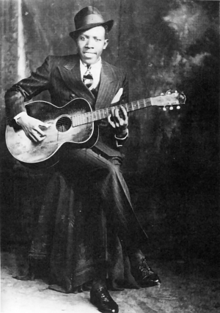
The man most associated with the crossroads blues legend was Robert Johnson, who was a virtual unknown when he died back in 1938. It wasn’t until twenty-five years after his death that Robert Johnson would attain lasting fame and immortality. When the blues craze hit Great Britain in the early 1960’s, Johnson’s record label decided to cash in and put out a quick compilation called “King of the Delta Blues Singers.” While the title sounded impressive, Robert Johnson was never the king of the delta blues singers, though his music was damned good.
The circumstances surrounding Johnson’s death in 1938 were murky, and his untimely death at the age of 27 kicked up all kinds of crazy rumors about the man selling his soul to the devil. The record label played up the myths too, knowing that controversy was good for record sales. For the record there was a Johnson who was said to have sold his soul to the devil back in Robert Johnson’s time, but his name was Tommy Johnson, and his music didn’t influence Eric Clapton and Jimmy Page the way Robert’s did.
While Robert Johnson didn’t sell his soul to the devil, there is still a lot of references to hoodoo in it, which I think are worth checking out. The song “Hellhound on my Trail” features more than lyrics about Johnson’s impending doom, he also sings about Hot Foot Powder:
You sprinkled hot foot powder mmmm
mmm around my door
all around my door
You sprinkled hot foot powder
all around your daddy’s door
Hotfoot Powder was said to rid people of bad neighbors, and cause ex-lovers to roam the world alone and unsatisfied. Not quite the devil, but at least it’s a bit a magickal.
In “Little Queen of Spades” Johnson sings about a woman wearing a mojo bag, which is a small bag used to carry magical items. Originally it was thought that mojo was a corruption of the English word magic, but it’s more likely that the word has origins in West Africa and is a corruption of “mojuba” which means prayer. A mojo bag is a prayer bag, or a portable spell you can carry with you.
The mojo bag features again in the song “Come On In My Kitchen” (arguably Johnson’s finest song), only this time he refers to it as a “nation sack.” The lyrics relate the bag’s magickal properties:
ah she’s gone
I know she won’t come back again
I’ve taken the last nickel
out of her nation sack
It’s bad hoodoo to take something out of one’s mojo bag . . . The linear notes to “Robert Johnson the Complete Recordings” state that a nation sack is “a small pouch worn around the neck in which keepsakes and valuables are kept” but that’s utter nonsense, and was obviously written by someone not familiar with hoodoo.
There are several other Johnson songs with references to the Crossroads and the Devil, but they don’t have the occult significance of the songs and lyrics outlined here. Some of them have nothing to do with what you think they do. “Crossroad Blues” is just about moving along, and not about any pacts with the devil.
So what’s the point of spending so much time on Robert Johnson? Well, he was a big influence on the Zeppelin, and his lyrics can be heard on songs like “The Lemon Song,” “Traveling Riverside Blues,” and “Trampled Underfoot.” More importantly, his popularity reintroduced the crossroads myth to the modern world, and much like Johnson, Zeppelin too was said to have sold their souls to the devil.
Jimmy Page and Aleister Crowley
“My interest in the occult started when I was 15. I do not worship the devil but Magick does intrigue me. Magick of all kinds. I read “Magick in Theory and Practice” when I was about 11 years old but it wasn’t for some years that I understood what it was all about.” -Jimmy Page
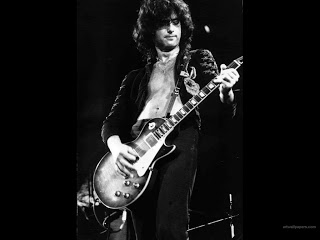
Led Zeppelin’s connection to the occult really begins with Jimmy Page, and he makes no effort to hide it. Pagey’s interviews are filled with references to True Will, Aleister Crowley, and magick. It’s been said that he is a member of the O.T.O., but I can’t verify it. (When I finish the Zeppelin workshop someone will always walk up to me and say “Hi, I’m with the O.T.O., and Jimmy Page is definitely a member.” Five minutes later someone will walk up to me and say “Hi, I’m with the O.T.O., and Jimmy Page is definitely not a member.” For those not in the know, the O.T.O. is a magickal order, which uses a lot of material from English magician Aleister Crowley. If you aren’t familiar with Crowley, go look him up on line before reading any further.) It’s obvious that the occult is more than just a passing fancy for Page though, and as recently as 2005 he’s been photographed wearing an O.T.O. t-shirt.
Page has been a fan of Aleister Crowley since his youth, and as an adult went so far as to buy Crowley’s old house at Loch Ness (Boleskine manner). The house its self is said to be haunted, according to legend a church full of parishioners burned down on the spot where the home was eventually erected and that their souls still turn up on the property from time to time. Up until recently it was a bed and breakfast.
In 1976 Page opened up an occult bookstore called “The Equinox Booksellers and Publishers” on Kensington High Street, London. It remained open for about ten years, and re-printed several of Crowley’s books. When asked why he opened up the store Jimmy said: “There was not one bookshop in London with a good collection of occult books and I was so pissed off not being able to get the books I wanted.”
According to those in the know, Jimmy Page has the largest collection of Crowleyana in private hands. He owns wands, clothing, books, letters, and various other ritual tools. While most of Jimmy’s friends say that the stuff is kept locked up in a vault, singer Michael Des Barres says that he and Page played with it all one afternoon, even going so far as to dress up in Crowley’s robes!
The respect that Page felt for Crowley rarely turned up in Led Zeppelin, but it did make the wax on Led Zeppelin III. Early pressings of the album have the words “Do what thou wilt” engraved into the runoff near the record’s label. The cover for “In Through the Outdoor’ features a figure who looks a lot like Aleister Crowley circa 1940. Besides these two specific instances the likeness and words of Aleister Crowley don’t feature in the albums of Led Zeppelin. (Page wasn’t alone in his reverence for Crowley, an image of the mage appears on the cover of The Beatles “Sergeant Pepper’s” album!)
Robert Plant and Hobstweedle
Robert Plant was a hippie in the truest sense. He loved the psychedelic sounds coming out of San Francisco, wore the tie-dye, and generally was a “peace and love” guy. Unlike Jimmy Page and John Paul Jones, Robert Plant wasn’t a veteran of London’s music scene; he grew up in the more rural Birmingham, like his buddy John Bonham (drums). Plant’s interests lied outside the realm of ceremonial magick, but many of them are still interesting for those of us trying to understand the mystical side of Led Zeppelin.
In the late 1960’s the works of J.R. Tolkien were seen as essential hippie literature. Hippies saw the hobbits as an ideal agrarian society, living off the land, and taking care of it. Plant was a fan of Tolkien before his Zeppelin tenure, eventually working in a band with a very Tolkienesque name called Obstweedle (usually misspelled Hobstweedle). Plant even named one of his dogs Strider, after the Lord of the Ring’s Aragon.
There are several Led Zeppelin songs with Tolkien related lyrics, and many of them happen to be among my favorite Zeppelin songs. “Ramble On” from Led Zeppelin II was the first time something from Middle Earth popped up in the music of Led Zeppelin. Robert sang:
Mine’s a tale that can’t be told, my freedom I hold dear
How years ago in days of old when magic filled the air
‘ twas in the darkest depths of Mordor, mm-I met a girl so fair
but Gollum and the evil one crept up and slipped away with her.
Yes, feel free to blame Robert Plant for all of the dragons and wizards that currently populate a great deal of heavy metal music.
The song “Misty Mountain Hop” was named after a fictional mountain range on Middle Earth. Besides the title, the song has very little to do with “The Lord of the Rings.”
So I’m packin’ my bags for the Misty Mountains
where the spirits go, now
Woo-over the hills where the spirits fly
The rest of the song is essentially about a love-in that got busted, it’s clever and cute but has nothing to do with the current discussion, not that I don’t like love-ins, and for those who were looking for one where I live, just try to show up when my wife’s not home.
Perhaps the best of Plant’s Tolkien inspired songs is “The Battle of Evermore” which coincidently is probably Zeppelin’s most mystical sounding song. “Evermore” is a hodge-podge of various traditions, mostly mixing Tolkien with Celtic mythology. Plant has stated that he wrote the song after reading a book on Scottish History, and many people have noticed similarities in the lyrics between “Evermore” and the Irish National Anthem!
The Tolkien influence is blatantly obvious in lyrics like “the Ringwraiths ride in black” but to attribute the entire song to Tolkien’s world seems shortsighted. Lyrics like “I’m waiting for the angels of Avalon” suggest that blending of mythologies and ideas. Plant has stated in interviews that when walking the English Countryside he can feel the ghosts of ancient warriors stirring on their former battlefields. It’s possible that these feelings also led to the composition of the lyrics.
It’s worth nothing that Celtic Mythology was very important to Plant and that he has studied it on and off for his entire life. His son Karac was named for a Celtic warrior who battled the Romans. Later in life, Plant would begin to explore the mystical heritage of India and the Middle East. The sounds and rhythms of those cultures, while hinted at in Zeppelin’s music, would be explored much more fully during Plant’s solo career and his brief “No Quarter” acoustic fling with Jimmy Page in 1994.
All About Led Zeppelin’s Fourth Album
Led Zeppelin’s greatest monument to the occult is their fourth album. Mistakenly called “Zoso” by some, or simply “Runes,” Led Zeppelin IV is an occult tour de force, from the album cover to the songs. Released in 1971, Led Zeppelin IV is the band’s best selling album, and most mysterious. It was released without a title, and the band’s name is glaringly absent from the album cover.
The album cover features a solitary old man with a bundle of sticks tied to his back. Jimmy Page has tried to popularize the idea that the man on the album cover represents a lifestyle that fosters harmony with nature. According to Page, the picture was found in a junk store by Robert Plant and then worked into the cover of the band’s fourth record. While it’s a cute story, it’s not true. The picture was created specifically for the album cover and bears a striking resemblance to English cunningman “Old” George Pickingill.
Pickingill was a turn of the century English cunningcrafter, with a rather sinister reputation. (Cunningcraft is the practice of English folk magick, and cunningmen and cunningwomen plied their trades in rural English villages for centuries. Use of cunningcraft was not seen as adversarial to Christianity either, and cunningmen were important parts of their communities, much like a blacksmith.) Instead of being held in high regard by those in his community, as many in his craft were, he was a social outcast and a figure of fear. Allegedly he was also the teacher of Aleister Crowley (and also English Witch Gerald Gardner), and founded several witch covens in rural England. While the witch coven stuff is utter nonsense, Pickingill was a real person, and the association with Crowley was a strong one by 1971, strong enough that the picture is no accident. Crowley probably never so much as met Pickingill (Old George makes no appearances in Crowley’s diaries), but the legend was a popular one in the early 70’s.
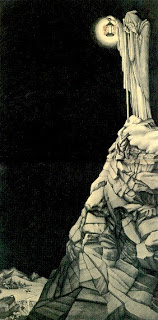
This past summer I was shown a tarot card that looked exactly like the figure on the cover of Led Zeppelin IV. I was told that the Ten of Wands was the real inspiration for the cover art, but going back through some tarot history, it seems that the reverse is true, the Zeppelin cover art served as inspiration for this one particular tarot card. A quick look at the Rider-Waite tarot (the most popular tarot deck in existence) clears up the confusion. Still, it’s nice to see Zeppelin influencing modern artists.
There are some very real tarot references in IV, most notably the album’s inner gatefold picture. Without a doubt that features the Hermit from the tarot, and Page has freely admitted to this during interviews. The picture was attributed to a friend of Page’s named Barrington Colby Mann, and was clearly based on the Hermit image in the Rider-Waite deck.
Page must have identified strongly with the Hermit, since the image of the Hermit shows up again in Zeppelin’s concert/movie The Song Remains the Same. After climbing a mountain Page comes across an image of himself that turns out to be the Hermit, either resulting in chuckles from the audience or murmurs of “that’s deep,” depending on the level of sobriety among those watching the film (Jason’s advice is to just focus on the music).
Whose symbol is whose? From left to right:
Page, Jones, Bonham, and Plant.
A bit more mysterious are the four runes or symbols which appear on the spine of the record jacket and the album sleeve. Each symbol is a reference to one of the four members of Led Zeppelin, as none of the band member’s names appear anywhere in the album credits. The idea for the four rune symbols probably belongs to Jimmy Page, and according to sources Page and Plant had their symbols custom made for the record, while Bonham and Jones picked their symbols from a book. Jones has said that he and Bonham’s symbols came from Rudolph Koch’s “Book of Signs,” which was handed to him by Page with the instructions to “pick something out.”
Jones’ symbol is a popular modern rune, depicting a circle intersected by three ovals. The rune stands for integrity and competence. John Bonham’s symbol is simply three interlocking circles, and either represents the trinity of Man/Woman/Child (Bonzo was a devoted family man) or Father/Son/Holy Ghost. Bonzo’s symbol also bore a close resemblance to the logo for Ballantine Beer.
The Egyptian Goddess of Truth and Justice, Ma’at inspired Plant’s symbol of a circle with a feather in the middle of it. Ma’at was the patroness of the pharaohs, and her symbol was the feather. It’s likely that the ideals of truth and justice appealed to Plant, and he might have been reading a book on Egyptian myth at the time he crafted his symbol.
The most mysterious of the four symbols belongs to Jimmy Page. To start with, it’s not the word “Zoso,” (though it sort of kind of looks like that) and to imply as much would probably piss off Jimmy. According to Jimmy the sign might have it’s origins in a series of doodles he jotted down while on the phone in the spring of 1971, but this is probably not the case.
Page’s symbol bears a strong resemblance to a glyph found in the 16th century book “Ars Magica Arteficii” by J. Cardan. In a section on astrological signs the “Zoso” rune appears almost as it does in 1971. The separate components of the rune sign indicate different things. The stylized “Z” is a reference to the astrological sign of Capricorn, which is Page’s sun-sign. The “oso” is open to various interpretations; the two most common are that it stands for “666,” or that it represents the alchemical symbol Mercury.
Besides the runes, the most mysterious part of Led Zeppelin IV is the song “Stairway to Heaven.” To tell you the truth, I’m not sure what the song means. I’ve seen it explained as a Christian allegory (really), and as a hymn to Satan. I’ve always thought it was a song about spiritual longing and desire, which seems to play into the symbolism on the album jacket. One thing I can tell you is that if you play it backwards you might hear the words “here’s to my sweet Satan.
Before we get into the backwards masking stuff I thought we should go to one of the sources for an opinion, here’s what Robert Plant had to say about the whole thing: “To me it’s very sad, because ‘Stairway to Heaven’ was written with the very best intention, and as far as reversing tapes and putting messages on the end, that’s not my idea of making music.”
In case you were wondering, the most infamous part of “Stairway to Heaven” is this one:
If there’s a bustle in your hedgerow, don’t be alarmed now
It’s just a spring clean for the May Queen.
Yes, there are two paths you can go by; but in the long run,
There’s still time to change the road you’re on.
Which allegedly comes out this way when played backwards:
Here’s to my sweet Satan
The one who whose little path would make me sad,
Whose power is fake/Satan.
He’ll give those with him 666.
There was a little toolshed where he made us suffer, sad Satan.
When you listen to the section in question, you can sort of hear something that sounds like “Here’s to my sweet Satan” but the rest of the verse is basically unintelligible. If Led Zeppelin was really working for the Devil I like to think they’d be a bit more upfront about it. It’s not like Jimmy hid his interest in Crowley.
The section in question is definitely not a backwards mask, backwards masking is a very deliberate technique, and a fine piece of studio trickery (especially in 1971). What’s so interesting about the Stairway/Satan problem is that the alleged shout out to the devil can be heard on both live and studio versions of the song! That argues in favor of coincidence, but in all honesty, I wouldn’t put a trick like that above Jimmy, he’d probably get a good laugh out of it.
While Zeppelin was always accused of Devil worship, the Stairway furor didn’t really begin until 1982, with you guessed it, an evangelical (radio) preacher, from California no less. Why anyone takes any of those people seriously is beyond me.
Summing Up
When I first started really listening to Zeppelin the occult influences of the band made me a little nervous. Back when I was 18, I was president of my church youth group, and not quite sure if I was ready to make a devotee of Aleister Crowley an idol. As I’ve grown up and widened my horizons, the occult stuff in Led Zeppelin has added to my Zeppelin obsession. It’s amazing that the two things I love more than anything have sort of ended up meeting in the middle, and those two things are, you guessed it, my Pagandom and the eternal music of Led Zeppelin.
May the Zeppelin ever soar!
https://www.youtube.com/watch?v=8pPvNqOb6RA

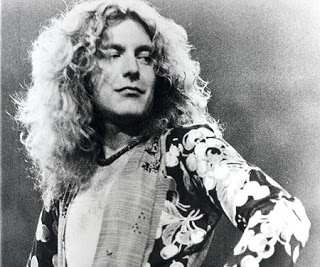
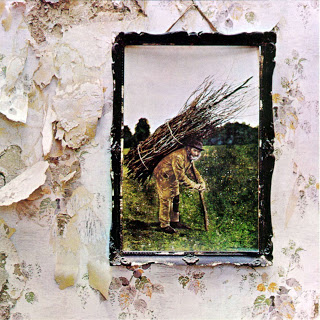

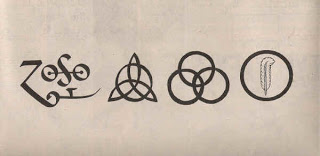


One Important Factor
Regarding Robert Johnson and his tale of selling his soul at the crossroads. It wasn’t his idea, he lifted it from an earlier bluesman who made the same claim in the late ’20’s. Tommy Johnson used that story to gain himself notoriety with the public. He is the origin of it (as far as anyone knows) having used it in 1928, not quite a decade before Robert adopted the same story for the exact same reason. He had a bit of fame for awhile but never made another recording after 1929 due to believing he had signed away his right to record.
Tommy Johnson lived beyond Robert Johnson’s lifespan and didn’t die until 1956.
[[{“fid”:”24099″,”view_mode”:”default”,”fields”:{“format”:”default”,”alignment”:””},”type”:”media”,”field_deltas”:{“1”:{“format”:”default”,”alignment”:””}},”attributes”:{“class”:”file-default media-element”,”data-delta”:”1″}}]]
Tommy Johnson (musician)